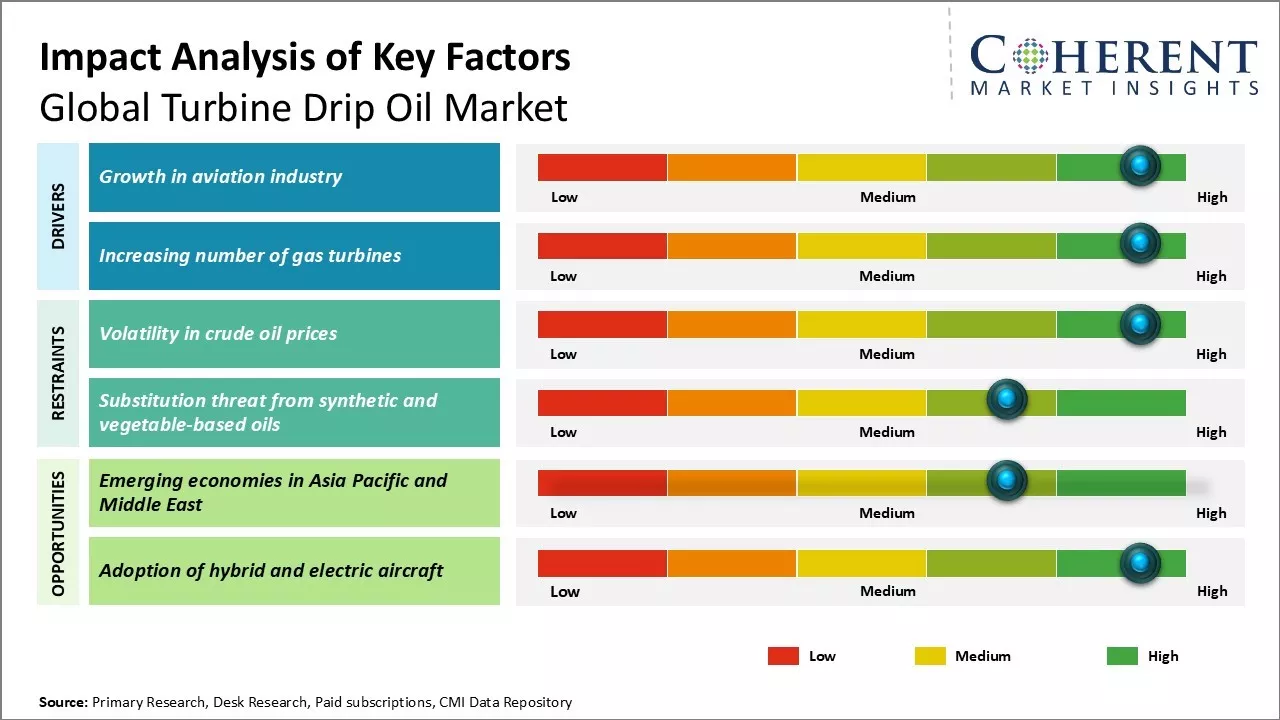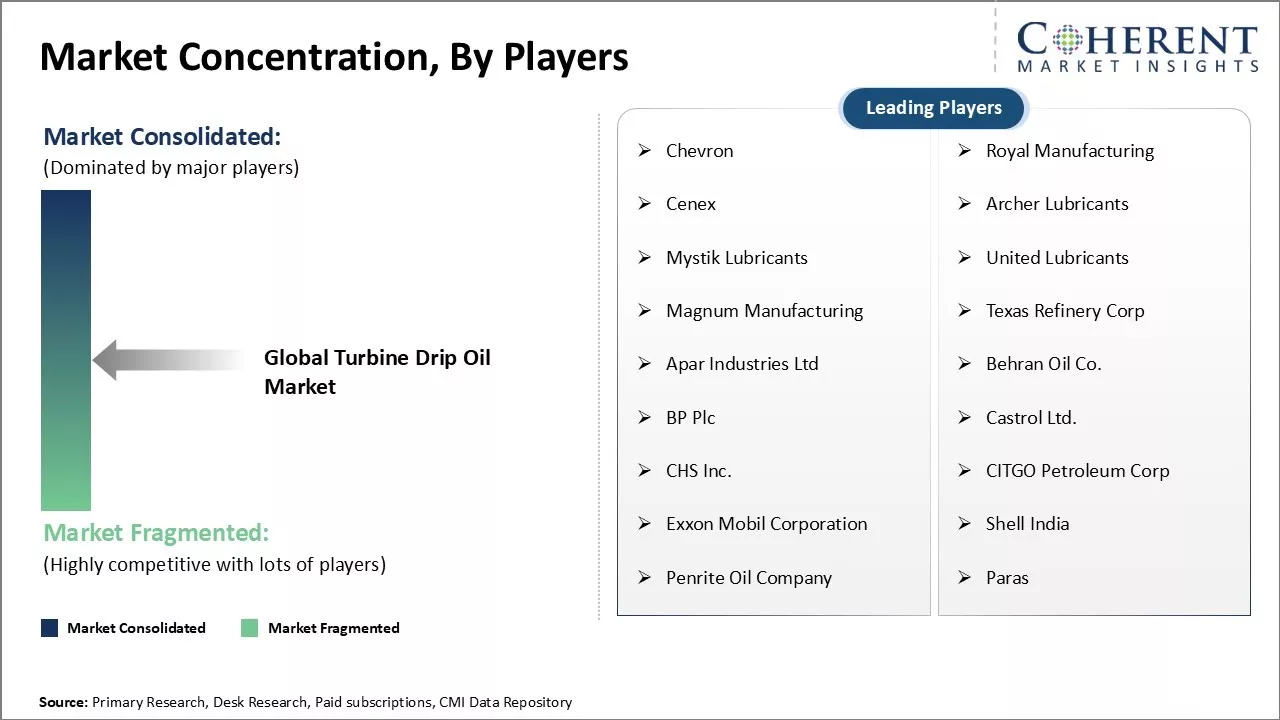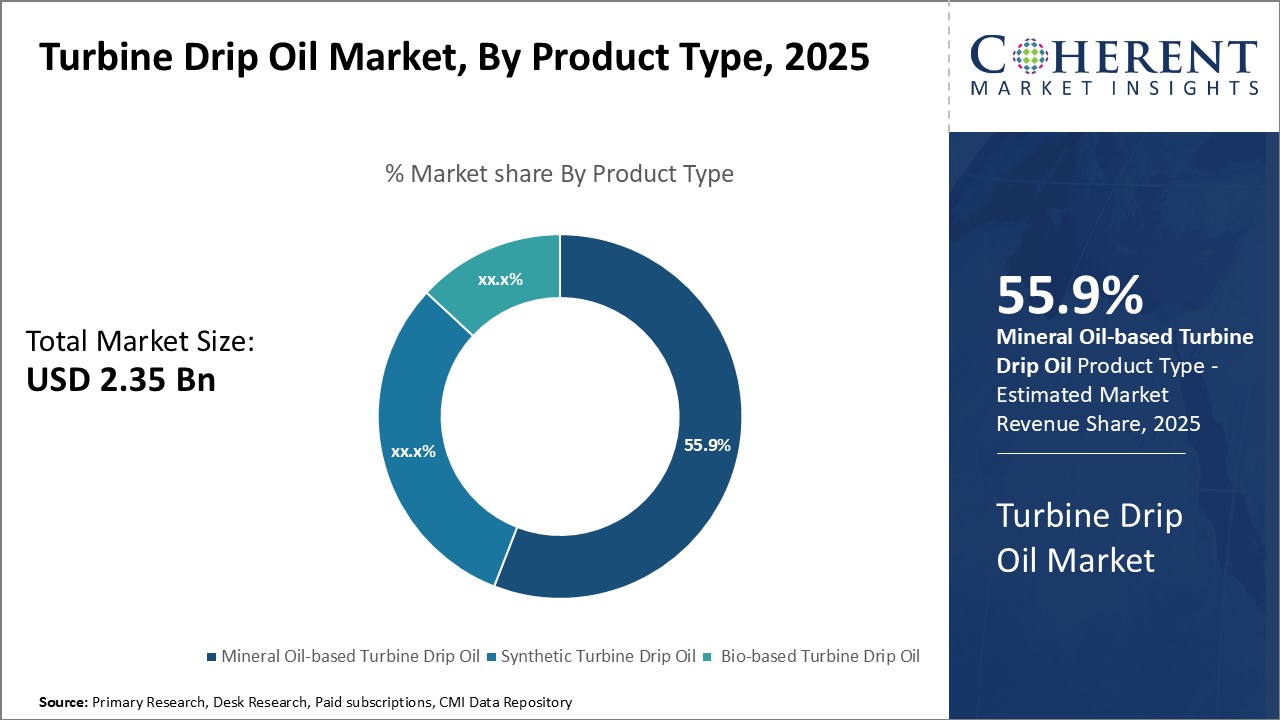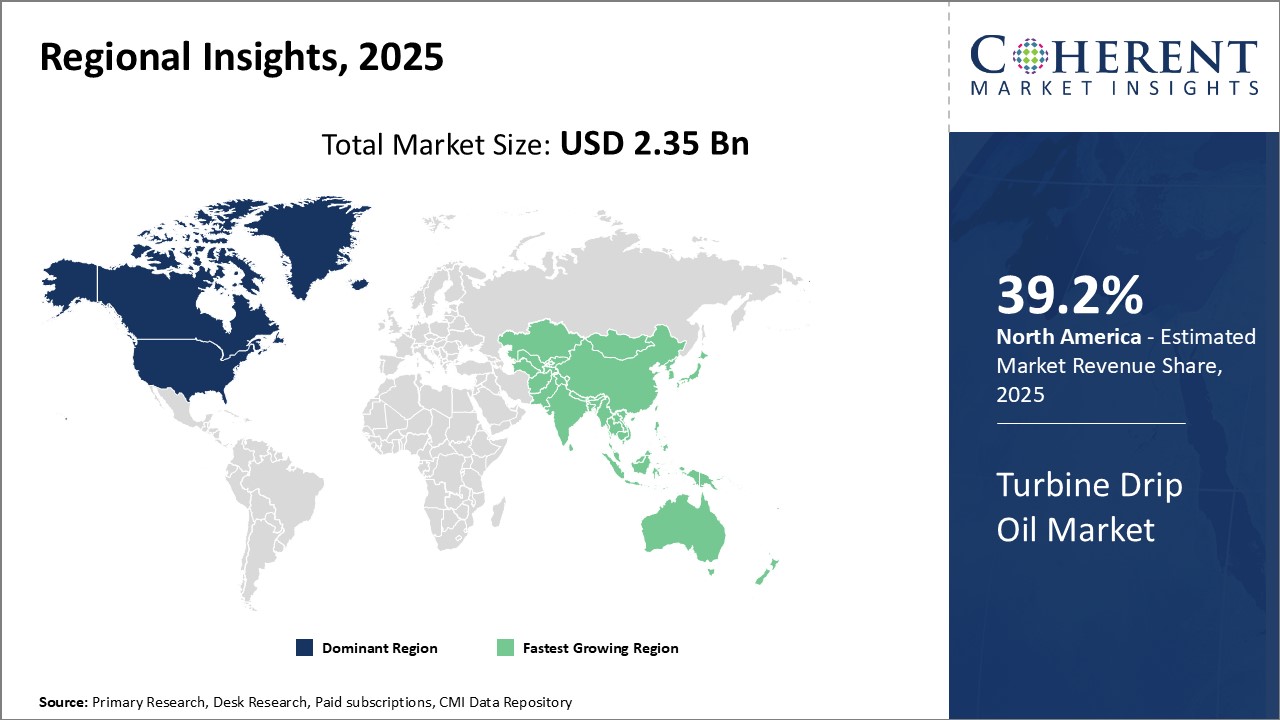Turbine Drip Oil Market Size and Trends
Global turbine drip oil market is estimated to be valued at USD 2.35 Bn in 2025 and is expected to reach USD 3.55 Bn by 2032, exhibiting a compound annual growth rate (CAGR) of 6.1% from 2025 to 2032.

Discover market dynamics shaping the industry: Download Free Sample
Growing concerns about operational efficiency and equipment reliability of turbine systems can boost demand for turbine drip oil. Proper oiling is crucial in preventing wear and tear of turbine parts under high pressure and temperature. Recent developments in turbine designs to improve heat transfer capabilities have increased the demand for advanced turbine oils with better thermal properties. Moreover, increasing energy demand and focus on power generation through renewable sources such as wind and solar can boost installation of new turbine systems, thus, driving the turbine drip oil market growth during the forecast period.
Growth in aviation industry
Global aviation industry has witnessed tremendous growth due to increasing demand for air travel especially in emerging markets of Asia Pacific and Middle East regions. More people opt for air travel due to rising incomes, increased connectivity and availability of low-cost airlines. This surge in passenger traffic has encouraged several airline companies to expand their fleet sizes as well as open new domestic and international routes. Airline operators are focusing on new aircraft purchases and fleet replacement programs to cater to rising demand. Major aircraft OEMs like Airbus and Boeing have received record breaking orders in recent years and their order backlogs extend for many years into the future, indicating sustained growth momentum for jet aircraft procurement.
This growth in the commercial aviation sector has augmented the fleet size of business/general aviation aircraft, which are used by corporate clients and high net worth individuals. There has been increasing preference among business executives for air travel due to time savings as compared to other modes of transportation. The demand for charter flights and private jet rentals has increased manifold especially from emerging economies. With expanding jet fleets, there has been increase in requirement for turbine drip oil, which acts as a lubricant for engines and ancillary components. The durable nature and heat-resistant properties of turbine oil makes it indispensable for smooth functioning of jet engines during takeoff, flight and landing cycles. Its high oxidation stability prevents acid formation and extends oil change intervals thereby lowering operating costs of airlines.
Continued strong orders for new aircraft over the next two decades to meet passenger and cargo traffic projections can boost demand from aviation sector. As fleet sizes increase across regions, more drip oil will be needed by airlines and turboprop/turbojet operators for reliable engine performance and minimum downtime. This expanding scope of jet aircraft operations worldwide can drive the global turbine drip oil market in the near future.
Market Concentration and Competitive Landscape

Get actionable strategies to beat competition: Download Free Sample
Increasing number of gas turbines
Gas turbines are used in power generation, marine propulsion, oil & gas industries, and other mechanical drive applications. Several countries worldwide are boosting investments in power projects based on gas turbine technology to diversify their energy mix and add new generation capacities. Thus, there has been huge demand for electricity and industrial output across developing nations that need efficient power plants. Due to their flexible, reliable operation and ability to utilize different fuels, there has been increase in adoption of gas turbine based combined cycle plants and auxiliary power units. Furthermore, their relatively smaller land footprint makes them suitable for locations with space constraints.
The marine sector has also witnessed strong demand for gas turbine installations mainly to propel large container vessels, cruise ships, ferries, and navy frigates. LNG carriers are another niche segment where gas turbines play a crucial role. With increasing global seaborne trade volumes and expansion of ports/terminals, more cargo and passenger ships need to be commissioned. Offshore oil/gas platforms also depend on gas turbines for power generation and mechanical drives in drilling/pumping duties. The active E&P activities taking place especially in deepwater fields across various geographies boosts turbine usage in floating production, storage and offloading (FPSO) vessels.
Due to rising deployments across major end-use industries that value their reliability, efficiency, and flexibility, original equipment manufacturers are manufacturing huge number of gas turbines. This upsurge is driving parallel requirement for turbine drip oil, which forms a critical part of the lubrication system preventing corrosion, reducing oxidation of moving components and extending the life of expensive turbine rotors. As new projects come online and existing facilities expand operations, there will be increase in consumption of turbine drip oil.
Key Takeaways from Analyst:
Global turbine drip oil market growth is driven by increasing energy demand and rising count of gas turbines worldwide. North America, home to several developing economies with high electricity needs, dominates current demand landscape and its large turbine fleet is expected to continue expansion fueled by new power projects. Asia Pacific and Europe are mature markets but maintenance requirements of aging turbines will ensure steady consumption.
Economic uncertainties can pose threat as any major slowdown can negatively impact new turbine sales and commissioning. Rising preference of renewable energy sources can also deter turbine-based power generation. Geopolitical tensions and international trade issues have the potential to disrupt supply chain dynamics.
Development of advanced turbine designs that improve efficiency while requiring lower lubricant volumes per operating hour point towards productivity upgrades. Growing turbine re-powering and life extension activities amid capacity constraints are opening new demand channels. Furthermore, end user emphasis on specialized high-performance oils suitable for most arduous operating conditions can boost demand.
Market Challenges: Volatility in crude oil prices
Global turbine drip oil market growth can be hampered due to volatility in crude oil prices. The unpredictable fluctuations in crude oil prices make it extremely difficult for turbine drip oil manufacturers to maintain stable production and pricing strategies. Shifts in crude oil prices affect the prices of key raw materials used by manufacturers such as petroleum derivatives. Unplanned spikes in raw material costs squeeze the margins of manufacturers. Fluctuations in demand from end-use industries such as oil & gas, wind, power generation due to changes in crude oil prices can hamper the market growth. It also becomes challenging for manufacturers to manage inventory levels efficiently. The volatility hampers long-term capital investments and planning by manufacturers. Unstable crude oil pricing environment adds to the operational risks and reduces the predictability of returns for players in global turbine drip oil market.
Market Opportunities: Emerging economies in Asia Pacific and Middle East
Global turbine drip oil market can witness significant growth opportunities due to emerging economies across Asia Pacific and Middle Eastern regions. Rapid industrialization and infrastructure development activities boosts demand for energy. Countries like China, India, Indonesia, and Saudi Arabia are heavily investing in power generation projects based on gas turbines and wind turbines to meet their growing energy needs. This impacts the consumption of turbine drip oils. These regions are witnessing expanding domestic manufacturing capacities for turbines. Establishment of local manufacturing plants by turbine OEMs implies higher localized procurement of auxiliary products like turbine drip oils. Thus, emerging markets in Asia Pacific and Middle East present substantial scope for turbine drip oil manufacturers to tap into new revenue streams and expand their geographical footprints in the near future.

Discover high revenue pocket segments and roadmap to it: Download Free Sample
Insights, By Product Type: Proven performance and cost-effectiveness
In terms of product type, mineral oil-based turbine drip oil segment is estimated to contribute the highest market share of 55.9% in 2025. Mineral oil-based turbine drip oil has been the product of choice for turbine lubrication due to its stable performance under extreme pressure and temperatures. Turbines operate under conditions of high heat, friction, and oxidization stress. Mineral oils are optimized to withstand these harsh environments through properties like high thermal stability, low volatility, and excellent lubricity. These form stable protective films on metal surfaces that shield turbines from wear during operations.
The additive packages in mineral oils also provide robust anti-oxidation, anti-wear, and anti-corrosion protection. By preventing oxidation break down and neutralizing corrosive contaminants, mineral oils can maintain turbine efficiency for longer operating periods between oil changes. Their hydrophobic nature further creates barriers against water contamination. With abilities to operate smoothly even with minor water ingress, mineral oils maximize uptime for turbines.
Mineral oils offer the most attractive value proposition. Being conventional petroleum-based lubricants, mineral oils benefit from massive economies of scale in production. This allows them to be supplied at competitive prices worldwide. Their price stability has also made them reliable for long-term budgeting and supply contracts. Operators prefer mineral oils for their proven performance reliability and overall low cost of ownership over the lifetime of turbines.
While synthetic and bio-based oils offer certain advantages, mineral oils achieve the right balance between performance and affordability needed for most applications. Only niche applications with special environmental or technical requirements consider alternatives to mineral oil-based lubrication.
Insights, By Application: Widespread use across power generation and industrial sectors
In terms of application, steam turbines segment is estimated to contribute the highest market share of 45.1% in 2025. Steam turbines are one of the most broadly applied and mission-critical rotating equipment worldwide. These form the core of conventional thermal power plants that generate electricity through the conversion of heat from coal, natural gas, biomass, and nuclear fuels into rotational energy. Significant numbers of steam turbines also power process industries like petrochemical, oil & gas, pulp & paper, and desalination.
The sheer scale of thermal power generation globally, accounting for over half of electricity production, drives substantial demand for steam turbine lubrication. Developed economies with aging fossil fuel-fired power plant fleets also contribute to steady replacement needs. Meanwhile, emerging economies are adding massive new coal and gas-fired capacities to meet their surge in electricity demand amid industrialization. All of these factors leads to increase in steam turbine installations and the volumes of turbine drip oil required for their operation over the forecast period.
Non-power industrial steam turbines witness widespread adoption. These are workhorses in diverse process industries for purposes like mechanical drive, power cogeneration, and steam distribution. User industries are expanding output to satisfy rising consumption globally. Mandates to improve energy efficiency and reduce carbon footprints increases the implementation of steam-based cogeneration systems. All these increases the consumption of turbine drip oils specifically formulated for steam turbine applications.
Steam turbines leverage the advantages of mineral oil-based lubricants to deliver high thermal stability, oxidation resistance, and low maintenance over long duty cycles. This ensures uninterrupted operations of electricity grids and industrial plants.
Regional Insights

Need a Different Region or Segment? Download Free Sample
North America currently dominates the global turbine drip oil market with an estimated market share of 39.2% in 2025, owing to its large installed base of gas turbines across utilities and industrial sectors. Stringent emission regulations in the U.S. and Canada boosts the need for efficient turbines with advanced lubrication solutions. This boosts turbine drip oil consumption. Major turbine OEMs such as General Electric and Siemens have a sizable manufacturing and service network across the region. Their focus on high performance turbine oils for new turbines as well as re-lubrication of installed fleets can drive the regional market growth. However, pricing pressure due to shale gas abundance may limit demand growth from the utilities sector.
Asia Pacific region is poised to emerge as the fastest growing market for turbine drip oils. Countries like China, India and Japan have been aggressively adding gas-fired power generation capacities mainly to reduce dependency on coal. This offers aftermarket opportunities for turbine lubrication products. Furthermore, initiatives such as 'Make in India' are attracting global turbine OEMs to set up local manufacturing plants. Their focus on supplying customized lubricant solutions can boost usage of turbine oils. Growth in the region's petrochemicals industry along with the expanding manufacturing sector can boost demand from industrial gas turbines. However, expensive import duties on lubricant imports in countries like India may support local turbine oil manufacturers.
Market Report Scope
Turbine Drip Oil Market Report Coverage
| Report Coverage | Details | ||
|---|---|---|---|
| Base Year: | 2024 | Market Size in 2025: | USD 2.35 Bn |
| Historical Data for: | 2020 To 2024 | Forecast Period: | 2025 To 2032 |
| Forecast Period 2025 to 2032 CAGR: | 6.1% | 2032 Value Projection: | USD 3.55 Bn |
| Geographies covered: |
|
||
| Segments covered: |
|
||
| Companies covered: |
Chevron, Royal Manufacturing, Cenex, Archer Lubricants, Mystik Lubricants, United Lubricants, Magnum Manufacturing, Texas Refinery Corp, Apar Industries Ltd, Behran Oil Co., BP Plc, Castrol Ltd., CHS Inc., CITGO Petroleum Corp, Exxon Mobil Corporation, Shell India, Penrite Oil Company, Paras |
||
| Growth Drivers: |
|
||
| Restraints & Challenges: |
|
||
Uncover macros and micros vetted on 75+ parameters: Get instant access to report
Turbine Drip Oil Industry News
- In 2020, ExxonMobil, a global leader in the energy industry, and GE, a multinational conglomerate, announced the launch of their new gas turbine oil. This collaborative effort combines the expertise of both companies to develop a high-performance lubricant specifically designed for gas turbines.
*Definition: Global turbine drip oil market involves the production and sales of turbine drip oils used for lubricating turbine equipment in power plants and various industrial applications. Turbine drip oils are premium quality lubricants specially formulated to coat and protect turbine parts from corrosion and wear. These provide an extra layer of protection for turbine bearings and gears during shutdown periods when the standard lubrication system is inactive.
Market Segmentation
- Product Type Insights (Revenue, USD Bn, 2020 - 2032)
-
- Mineral Oil-based Turbine Drip Oil
- Synthetic Turbine Drip Oil
- Bio-based Turbine Drip Oil
- Application Insights (Revenue, USD Bn, 2020 - 2032)
- Steam Turbines
- Gas Turbines
- Hydro Turbines
- Regional Insights (Revenue, USD Bn, 2020 - 2032)
- North America
- U.S.
- Canada
- Latin America
- Brazil
- Argentina
- Mexico
- Rest of Latin America
- Europe
- Germany
- U.K.
- Spain
- France
- Italy
- Russia
- Rest of Europe
- Asia Pacific
- China
- India
- Japan
- Australia
- South Korea
- ASEAN
- Rest of Asia Pacific
- Middle East
- GCC Countries
- Israel
- Rest of Middle East
- Africa
- South Africa
- North Africa
- Central Africa
- North America
- Key Players Insights
- Chevron
- Royal Manufacturing
- Cenex
- Archer Lubricants
- Mystik Lubricants
- United Lubricants
- Magnum Manufacturing
- Texas Refinery Corp
- Apar Industries Ltd
- Behran Oil Co.
- BP Plc
- Castrol Ltd.
- CHS Inc.
- CITGO Petroleum Corp
- Exxon Mobil Corporation
- Shell India
- Penrite Oil Company
- Paras
Share
Share
About Author
Yash Doshi is a Senior Management Consultant. He has 12+ years of experience in conducting research and handling consulting projects across verticals in APAC, EMEA, and the Americas.
He brings strong acumen in helping chemical companies navigate complex challenges and identify growth opportunities. He has deep expertise across the chemicals value chain, including commodity, specialty and fine chemicals, plastics and polymers, and petrochemicals. Yash is a sought-after speaker at industry conferences and contributes to various publications on topics related commodity, specialty and fine chemicals, plastics and polymers, and petrochemicals.
Missing comfort of reading report in your local language? Find your preferred language :
Transform your Strategy with Exclusive Trending Reports :
Frequently Asked Questions
EXISTING CLIENTELE
Joining thousands of companies around the world committed to making the Excellent Business Solutions.
View All Our Clients
